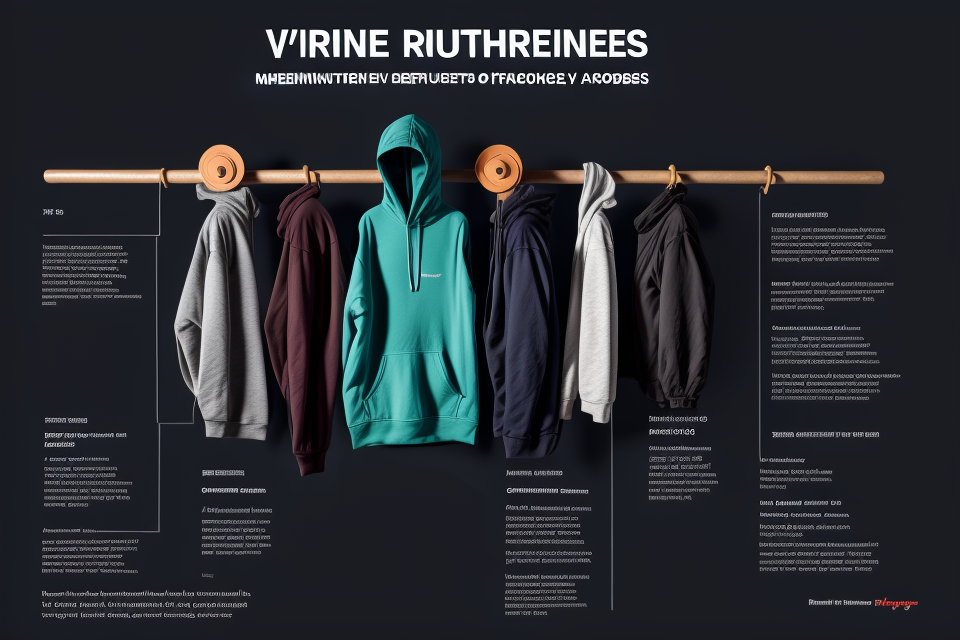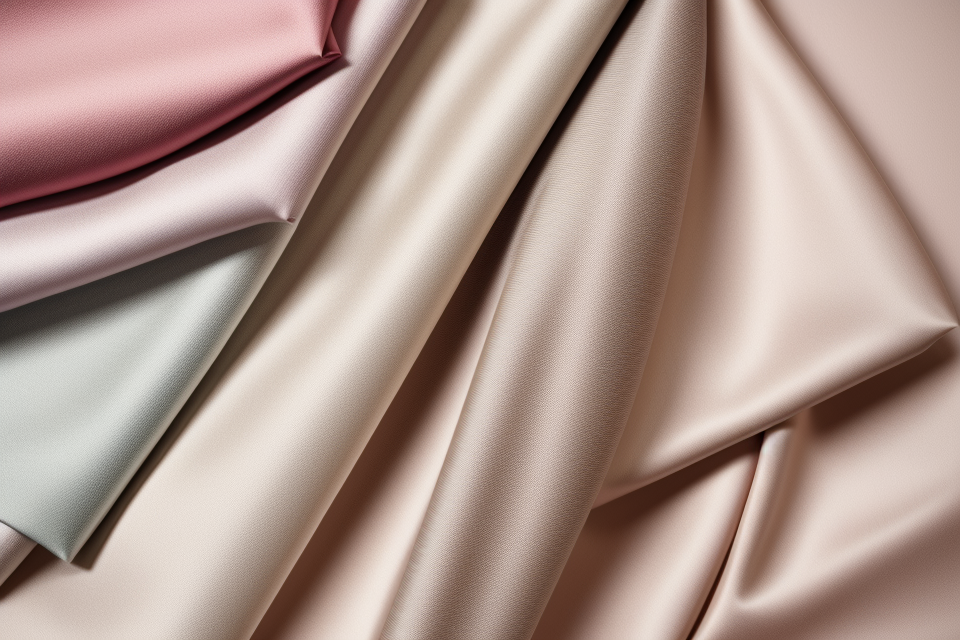
Are you tired of your favorite hoodie shrinking after just a few washes? It’s a common problem that many people face, but it doesn’t have to be. The key is to choose the right material for your hoodie. Some materials are more prone to shrinking than others, but there are options out there that are designed to resist shrinking. In this article, we’ll explore the best materials for hoodies that don’t shrink, so you can keep your favorite sweatshirt looking new for years to come. From high-quality cotton to advanced synthetic fibers, we’ll cover the pros and cons of each option and help you make an informed decision. So, whether you’re a fan of classic cotton or trendy fleece, read on to discover the best material for your hoodie.
The best material for hoodies that don’t shrink is typically made from a blend of cotton and polyester. This type of fabric is known for its durability and resistance to shrinking, making it a popular choice for hoodies. The cotton provides softness and comfort, while the polyester helps to prevent the fabric from stretching or shrinking. Additionally, using a high-quality fabric with a tight weave can also help to prevent shrinking. It’s also important to follow proper care instructions, such as washing the hoodie in cold water and avoiding using fabric softener, to help prevent shrinking.
Understanding Hoodie Materials
Factors to Consider When Choosing Hoodie Materials
When selecting the best material for a hoodie that won’t shrink, it’s important to consider several factors. These include the fabric’s composition, weight, and texture, as well as the garment’s intended use and care instructions. Here are some key factors to keep in mind when choosing hoodie materials:
- Composition: Different fabrics are made from various fibers, each with its own unique properties. For example, cotton is a popular choice for hoodies due to its softness and breathability, but it is also prone to shrinking and wrinkling. On the other hand, synthetic fibers like polyester and nylon are more durable and resistant to shrinking, but they may not be as comfortable or breathable as natural fibers.
- Weight: The weight of a fabric refers to its thickness and density. Heavier fabrics, such as denim or fleece, are typically more durable and insulating, but they may also be more prone to shrinking. Lighter fabrics, such as chiffon or silk, are more delicate and prone to wrinkling, but they may also be more prone to shrinking.
- Texture: The texture of a fabric can also affect its shrinkage. For example, a smooth and dense fabric like satin may be less prone to shrinking than a textured fabric like corduroy. Additionally, some fabrics, such as velvet, may be more prone to shrinking in certain directions, such as the grain.
- Intended use: The intended use of the hoodie can also impact the choice of material. For example, a hoodie intended for outdoor activities may require a more durable and water-resistant fabric, while a hoodie for casual wear may be more suitable for a lighter and softer fabric.
- Care instructions: The care instructions for the hoodie can also impact its shrinkage. For example, if a hoodie is machine washed in hot water, it may shrink more than if it was washed in cold water or by hand. Additionally, drying a hoodie on a high heat setting can cause it to shrink more than air-drying or tumble-drying on a low heat setting.
By considering these factors, you can select the best material for a hoodie that won’t shrink and meet your specific needs and preferences.
Common Types of Hoodie Materials
When it comes to hoodies, there are several materials to choose from. Here are some of the most common types of hoodie materials:
- Cotton: Cotton is a popular choice for hoodies because it is soft, comfortable, and breathable. However, it is also prone to shrinking, especially if it is not washed properly. To prevent shrinkage, it is important to wash cotton hoodies in cold water and avoid using fabric softeners.
- Polyester: Polyester is a synthetic material that is known for its durability and resistance to shrinking. It is also moisture-wicking, making it a good choice for active wear. However, it can be less breathable than cotton and may feel less comfortable against the skin.
- Cotton-Polyester Blends: Blending cotton with polyester can create a material that offers the best of both worlds. The cotton provides softness and breathability, while the polyester adds durability and resistance to shrinking. This makes it a popular choice for hoodies that need to withstand wear and tear.
- Satin: Satin is a glossy, smooth material that is often used for dressier hoodies. It is made from polyester or nylon and is known for its lustrous finish. However, it can be less warm than other materials and may require special care when washing.
- Fleece: Fleece is a warm, fuzzy material that is often used for layering under jackets or as a standalone hoodie. It is made from polyester or cotton and is known for its warmth and comfort. However, it can be less breathable than other materials and may not be suitable for hot weather.
These are just a few examples of the many types of materials that can be used to make hoodies. When choosing a material, it is important to consider factors such as comfort, durability, and functionality.
The Pros and Cons of Different Hoodie Materials
Cotton
Cotton is a popular choice for hoodies due to its softness and comfort. However, it is also prone to shrinking, which can be a concern for those who want their hoodies to maintain their size and shape. Here are some pros and cons of using cotton as a material for hoodies:
Pros:
- Soft and comfortable to wear
- Good insulation and warmth
- Natural material that is breathable
- Versatile and can be worn in a variety of settings
Cons:
- Prone to shrinking in the wash
- Can be more expensive than other materials
- May not be as durable as other materials
- Can wrinkle easily
Polyester
Polyester is a popular choice for hoodies due to its durability and resistance to shrinking. It is a synthetic fiber made from polymers of polyester resin. One of the main advantages of polyester is that it can withstand high temperatures, making it suitable for machine washing and drying without losing its shape or size. Additionally, polyester is lightweight, breathable, and quick-drying, making it a comfortable choice for wearers.
However, there are some downsides to consider when choosing polyester for hoodies. One major disadvantage is that it can feel less soft and comfortable against the skin compared to natural fibers like cotton. Additionally, polyester is prone to pilling, which can create unsightly bumps on the surface of the fabric.
Another factor to consider is the environmental impact of polyester. While it is recyclable, the production process can generate significant amounts of greenhouse gas emissions and use large amounts of energy.
Overall, while polyester has its advantages, it may not be the best choice for everyone. Those who prioritize softness and comfort may prefer other materials, while those who value durability and sustainability may opt for polyester.
Fleece
Fleece is a popular material used in the production of hoodies due to its warmth and softness. It is made from synthetic fibers, such as polyester, which are designed to trap air between the fibers, creating a layer of insulation that keeps the wearer warm. The texture of fleece is often compared to that of a sheep’s wool, which contributes to its popularity among consumers.
One of the main advantages of fleece is its ability to retain its shape and size, even after multiple washes. This makes it an ideal material for hoodies that are prone to shrinking, as it will not lose its original form. Additionally, fleece is relatively inexpensive to produce, which makes it an attractive option for clothing manufacturers.
However, there are some drawbacks to using fleece as a material for hoodies. For example, it is not a very breathable fabric, which can make it uncomfortable to wear in hot weather. Additionally, fleece is not a very durable material, and can easily become damaged if it is not cared for properly. This can result in the hoodie becoming pill-laden or losing its shape over time.
In conclusion, fleece is a popular material for hoodies due to its warmth and softness, as well as its ability to retain its shape and size. However, it is not the best material for hoodies that don’t shrink, as there are other options available that offer similar benefits without the drawbacks of fleece.
Blends
Blends are a popular choice for hoodies because they offer a combination of different materials, such as cotton and polyester. The blend of materials can provide a number of benefits, including durability, moisture-wicking, and breathability. However, it’s important to note that not all blends are created equal, and some may shrink more than others.
Some common blends used in hoodies include:
- Cotton/polyester blend: This blend is known for its durability and moisture-wicking properties. It’s also relatively lightweight and breathable, making it a good choice for active wear. However, it may shrink more than other blends.
- Polyester/cotton blend: This blend is known for its durability and resistance to shrinking. It’s also relatively lightweight and breathable, making it a good choice for active wear. However, it may not be as soft as a 100% cotton hoodie.
- Cotton/spandex blend: This blend is known for its softness and stretchiness. It’s also relatively lightweight and breathable, making it a good choice for active wear. However, it may not be as durable as other blends.
When choosing a blend for a hoodie, it’s important to consider the intended use and care instructions. If the hoodie will be washed frequently or exposed to heat, it’s important to choose a blend that is resistant to shrinking and fading. If the hoodie will be worn for casual, everyday wear, a softer blend may be more comfortable.
How to Prevent Hoodies from Shrinking
Proper Care and Maintenance
Maintaining your hoodie properly is key to preventing it from shrinking. Here are some tips to keep your hoodie in good condition:
- Wash your hoodie inside out: This helps to protect the logo or design on the front of the hoodie from damage. It also helps to prevent the dye from bleeding and causing stains.
- Use cold water: Using cold water to wash your hoodie helps to prevent it from shrinking. Hot water can cause the fibers in the fabric to shrink and lose their shape.
- Use a gentle detergent: Using a gentle detergent that is designed for cotton or synthetic materials helps to prevent your hoodie from shrinking. Avoid using bleach or fabric softener, as these can damage the fabric.
- Avoid tumble drying: Tumble drying can cause your hoodie to shrink and lose its shape. Instead, hang your hoodie up to dry or use a low heat setting in the dryer.
- Iron your hoodie inside out: If you need to iron your hoodie, make sure to do it inside out. Use a low heat setting and avoid ironing over any decorative elements, such as logos or embroidery.
By following these tips, you can help to prevent your hoodie from shrinking and keep it looking its best for years to come.
Choosing the Right Washing Method
Properly washing your hoodie is essential to prevent it from shrinking. Here are some tips on choosing the right washing method:
- Wash your hoodie inside out: To prevent your hoodie from shrinking, wash it inside out. This way, the outer fabric won’t be exposed to water, which can cause it to shrink.
- Use cold water: Using cold water is better for your hoodie than hot water. Hot water can cause the fibers in your hoodie to shrink and become damaged.
- Avoid using bleach: Bleach can cause the fabric in your hoodie to become weak and fragile. It can also cause the colors to fade or become uneven.
- Choose the right washing machine setting: Depending on the type of fabric your hoodie is made of, you may need to choose a specific washing machine setting. For example, if your hoodie is made of cotton, you can choose a gentle cycle. If it’s made of synthetic material, you can choose a setting that is specifically designed for synthetic fabrics.
- Dry your hoodie on a clothesline or a drying rack: Avoid using the dryer for your hoodie. Instead, dry it on a clothesline or a drying rack. This will help prevent your hoodie from shrinking. If you must use the dryer, use a low heat setting and remove the hoodie from the dryer as soon as it’s dry.
By following these tips, you can help prevent your hoodie from shrinking and keep it looking great for years to come.
Tips for Shrink-Free Hoodies
- Proper Laundry Techniques
- Wash hoodies inside out to prevent fabric from stretching
- Use cold water, as hot water can cause fibers to shrink
- Avoid using bleach or fabric softener, as they can weaken the material
- Tumble dry on low heat or air dry to minimize shrinkage
- Proper Storage
- Hang hoodies up to prevent wrinkles and creases
- Fold hoodies carefully, ensuring that they are not stretched or folded unevenly
- Keep hoodies in a cool, dry place, away from direct sunlight
- Choosing the Right Material
- Opt for materials that are known for their durability and resistance to shrinkage, such as cotton or bamboo
- Consider blends that include materials like polyester or spandex, which can provide added stretch and flexibility without shrinking
- Look for hoodies made from moisture-wicking and quick-drying fabrics, which can help prevent shrinkage caused by sweat or moisture
- Proper Maintenance
- Regularly check hoodies for any signs of wear or damage, and repair or replace as needed
- Avoid using harsh chemicals or abrasive cleaners, as they can weaken the material and cause shrinkage
- Consider investing in a lint roller or brush to remove any loose fibers or lint that can cause shrinkage or damage to the fabric.
Final Thoughts on Choosing the Best Material for Hoodies That Don’t Shrink
When it comes to choosing the best material for hoodies that don’t shrink, there are a few key factors to consider. First and foremost, it’s important to look for materials that are made from high-quality fibers that are known for their durability and resistance to shrinkage. This can include materials like cotton, polyester, and nylon, which are all known for their ability to withstand repeated washing and drying without losing their shape or size.
Another important factor to consider is the weight and texture of the material. Heavier and thicker materials are generally more resistant to shrinkage than lighter and thinner ones, so if you’re looking for a hoodie that won’t shrink over time, it’s worth opting for a heavier weight and texture.
In addition to these factors, it’s also important to consider the care instructions for the material. Some materials may be prone to shrinkage even if they are made from high-quality fibers, so it’s important to follow the care instructions carefully to prevent shrinkage. This may include washing the hoodie in cold water, using a gentle cycle, and avoiding high heat settings when drying.
Overall, when it comes to choosing the best material for hoodies that don’t shrink, it’s important to prioritize durability, weight, and texture, and to follow the care instructions carefully to prevent shrinkage. By doing so, you can ensure that your hoodie stays in great condition for years to come.
FAQs
1. What are some materials that are prone to shrinking in hoodies?
Hoodies are typically made from a variety of materials, including cotton, polyester, and synthetic blends. Of these materials, cotton is the most prone to shrinking. This is because cotton is a natural fiber that absorbs water easily, which can cause it to shrink when washed or exposed to moisture. Polyester and synthetic blends, on the other hand, are less prone to shrinking as they are more resistant to water and retain their shape better.
2. What are some materials that don’t shrink in hoodies?
There are several materials that are known for their resistance to shrinking in hoodies. These include polyester, nylon, and spandex. Polyester is a synthetic fiber that is known for its durability and resistance to shrinking. Nylon is another synthetic fiber that is strong and resistant to water, making it a good choice for hoodies that need to withstand a lot of wear and tear. Spandex is a stretchy fabric that is often used in hoodies to provide a comfortable fit.
3. How can I prevent my hoodie from shrinking?
There are several ways to prevent your hoodie from shrinking. One of the most effective methods is to wash it in cold water, as hot water can cause the fabric to shrink. You should also avoid using fabric softener, as this can further weaken the fibers and make them more prone to shrinking. Additionally, you can choose a hoodie made from a material that is known for its resistance to shrinking, such as polyester or nylon.
4. Is it better to machine wash or hand wash my hoodie?
Both machine washing and hand washing have their own advantages and disadvantages when it comes to preventing shrinking in hoodies. Machine washing is generally faster and more convenient, but it can be tough on the fibers of the hoodie and cause them to shrink. Hand washing, on the other hand, is gentler on the fibers, but it can be time-consuming and may not be as effective at removing stains and dirt. Ultimately, the best method will depend on the specific material of your hoodie and your personal preferences.
5. Can I still wear a hoodie that has shrunk?
Yes, you can still wear a hoodie that has shrunk, but it may not fit as well as it did before. If your hoodie has shrunk significantly, you may need to size up to ensure a comfortable fit. Additionally, a hoodie that has shrunk may look baggy or wrinkled, which can affect its overall appearance. If you’re concerned about the fit or appearance of your hoodie, you may want to consider having it professionally altered or purchasing a new one.


